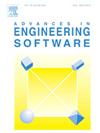Data integration framework for multi-level information modelling and numerical analysis of deteriorated RC bridges
IF 4
2区 工程技术
Q2 COMPUTER SCIENCE, INTERDISCIPLINARY APPLICATIONS
引用次数: 0
Abstract
Structural assessment of deteriorated bridges is a vital step in the decision-making process for asset management. This paper proposes a novel Building Information Modelling (BIM) and Finite Element (FE) integration framework to analyse and retrofit damaged Reinforced Concrete (RC) bridges. The drive behind the framework is to increase the efficiency and accuracy of structural assessment. To this end, a software tool called Bridge Damage Information Modeller (BriDIM) is developed. Two-way automated data interpretation and exchange between BIM and FE is created to allow for the evaluation of the residual structural capacity against limit states based on a comprehensive multi-level numerical model. BriDIM automatically feedback the FE analysis results into BIM environment for visualisation. The research findings suggest that utilising BIM as a database that includes structural specifications, damage information and retrofitting aspects brings benefits in terms of consistency, modelling and computational efficiency throughout the life cycle of a structure. The proposed framework transforms the way we approach assessments by consolidating all mechanical damage-related information into one 3D visualised BIM model. Ultimately BriDIM holds potential in facilitating the development of Digital Twins for existing structures. The model can be used to create scenarios of various damage combinations and provide a reliable tool to simulate the current condition of the bridge and the expected conditions of the bridge in case of damage propagation or change in environmental conditions.
求助全文
约1分钟内获得全文
求助全文
来源期刊

Advances in Engineering Software
工程技术-计算机:跨学科应用
CiteScore
7.70
自引率
4.20%
发文量
169
审稿时长
37 days
期刊介绍:
The objective of this journal is to communicate recent and projected advances in computer-based engineering techniques. The fields covered include mechanical, aerospace, civil and environmental engineering, with an emphasis on research and development leading to practical problem-solving.
The scope of the journal includes:
• Innovative computational strategies and numerical algorithms for large-scale engineering problems
• Analysis and simulation techniques and systems
• Model and mesh generation
• Control of the accuracy, stability and efficiency of computational process
• Exploitation of new computing environments (eg distributed hetergeneous and collaborative computing)
• Advanced visualization techniques, virtual environments and prototyping
• Applications of AI, knowledge-based systems, computational intelligence, including fuzzy logic, neural networks and evolutionary computations
• Application of object-oriented technology to engineering problems
• Intelligent human computer interfaces
• Design automation, multidisciplinary design and optimization
• CAD, CAE and integrated process and product development systems
• Quality and reliability.
 求助内容:
求助内容: 应助结果提醒方式:
应助结果提醒方式:


